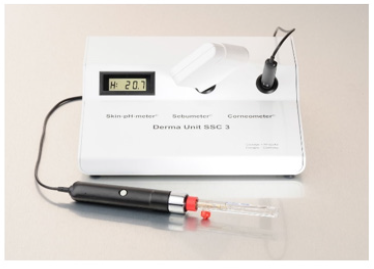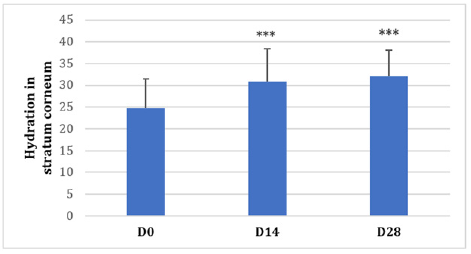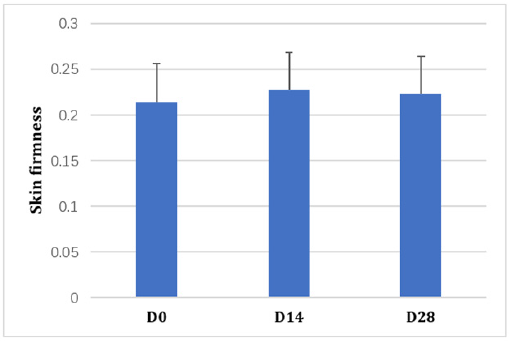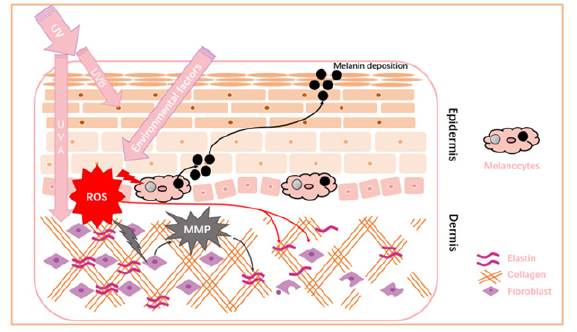Research Article 
 Creative Commons, CC-BY
Creative Commons, CC-BY
The Efficacy and Safety Evaluations of a Formulation SIDAI® on the Improvement of Skin Conditions: Results of a Clinical Study
*Corresponding author: Dan Cheng, R&D Center, Shanghai Lithy One Health Group, Shanghai, China.
Received: April 07, 2022; Published: April 25, 2022
DOI: 10.34297/AJBSR.2022.16.002198
Abstract
Facial beauty is one of the most important priorities considered especially by female individuals. The cosmetic market in China has been growing rapidly during the past 10 years due to increased population and consumption potential. As they are well educated and thus care more about both functionality and safety, evidence-based natural ingredients have been becoming welcomed and favored. In our study, a single-blinded, randomized and self-controlled study was conducted to investigate the efficacies and safety of a formulation comprising five natural ingredients. Instrumentation analysis showed the improvement of skin conditions regarding skin hydration after topical application of this formulation for 14 and 28 consecutive days. Also, self-assessment of those individuals showed a remarkable satisfaction rate of the formulation. Crucially, no adverse event was reported during this trial regarding the safety and tolerance of this formulation. Fundamentally, this formulation could be an ideal candidate for the recovery, restoration and maintenance of the skin conditions due to solid evidence-based function, safety and tolerance.
Introduction
China has become the most potential market for cosmetics due to large population and rapid economic growth. In the last decade, the largest annual growth rate of cosmetic sales in China has been up to 41% while the average rate is 23.8%. Meanwhile, the functions of cosmetics are being divided into more specific categories such as hydration, anti-aging, whitening and so on. Human skin, which is the largest organ of a human body, has played an essential role in the protection, restoration and maintenance of the body’s physiological homeostasis [1,2]. The mechanism of skin aging lies in the loss of skin tissues at an average rate of 7% annually [3]. One of the crucial aspects is the loss the extracellular matrix (ECM) that mainly includes collagen, elastin fibers and proteoglycans and so on. Except physiological factors such as the slowdown of the cell division with telomere loss, there are many other environmental factors that contribute to skin aging [4]. For instance, when skin is exposed to ultraviolet radiation (UVR) emitted by the sun and electronic devices, skin damages such as sunburn, photo aging, cutaneous malignancy might occur [5,6].
It has been demonstrated utilizations of certain natural products can be an effective way in recovering the skin from aging caused by both the internal and external factors. For instance, a prospective, randomized and controlled study proved that daily supplementation of collagen peptide at 3g significantly improved skin hydration and elasticity [7]. The oral administration of collagen tripeptide to hairless mice exposed to UVR showed significantly anti-photo aging effects including reduced wrinkle formation, skin thickening, and trans-epidermal water loss [8]. Meanwhile, fruit and herbal extracts enriched in anti-oxidants may also serve as good candidates to protect skin from aging. A clinical study showed the minimal erythema dose had been increased while sunburn cells and melanin levels were reduced after oral administration of a specific melon concentrate rich in superoxide dismutase [9]. Apart from effective functions, there has been a lot of scientific reports that demonstrated the safety and good tolerance of those natural ingredients, which is also among the first priorities for individuals for the consideration of a specific cosmetic product [10].
In our study, a formulation of five natural ingredients including collagen peptide, proteoglycan, witch hazel extract, fullerene and hyaluronic acid named SIDAI® has been used for skin anti-aging purpose. To evaluate its efficacies regarding improvement of skin conditions such as skin hydration, elasticity and its safety, a randomized, single-blinded and self-controlled study has been conducted.
Materials and Methods
Testing product
SIDAI® composition were provided by Changzhou Bianxi Trade Co., Ltd, including several ingredients including collagen peptide, proteoglycan, witch hazel extract, fullerene and hyaluronic acid.
Study design/Intervention
The investigation of the effects on the composition on 33 healthy female subjects (18-65 years old) was carried out by a single-blinded, randomized and self-controlled trial in 28 consecutive days of topical application in their forearms. All participants acknowledged their benefits and risks from this trial and sign the consent form. Thirty subjects completed the study and three withdrew due to personal reasons. The rest individuals were willing to cooperate during the trial and report any adverse events. Also, they agree not to use any other cosmetics that have an impact on the results during the trial. The participants applied SIDAI® in their forearms once a day.
Outcome Measures
All tests were conducted at a third-party analytical and testing center called WEIPU Biotechnology in Shanghai, China. Before using the test product in the front of the arm, after 14 days and 28 days of continuous use, the moisture content of stratum corneum, skin elasticity and skin firmness in the area of the forearm were tested for each subject. The subjects shall clean the inside of forearms of both hands and stay in the testing room for at least 20 minutes before testing, where the temperatures are from 20.1 ℃ to 21.2 ℃ and the relative humidity are from 48.1% to 53.2%. During this period, they shall not drink water and drinks, and their forearms shall be exposed and kept relaxed. The laboratory technician selects one area (3cm × 3cm) inside the forearm of both hands. The evaluation results before and after the use of the product are compared by statistical test methods to determine whether there is a statistical difference.
Measurement of Hydration at Skin Surface
Corneometer® was used to characterize the hydration level of the skin surface (Figure 1). The probe allows very quick measurement (1 s) by capacitance measurement that avoids the impact of skin salts. The Larger value, the higher extent of hydration at skin surface is.
Measurement of Elasticity
The Cutometer® (Figure 2), which applies negative pressure and deforms the skin mechanically, was used to measure the skin elasticity. The penetration depth in mm/time shown in curves displays firmness (the resistance of the skin to the negative pressure) and elasticity (its ability to return into its original position). From these curves, parameters related to elastic and viscoelastic properties of skin surface can be calculated. The skin is more elastic as the value is getting closer to 1.
Subjective Assessments of Treatment Effects
All subjects completed the self-evaluation questionnaire of SIDAI® at D0 and D28. The efficacy score of the test products was 0-9 points (0 point indicates they are not satisfied with the efficacy of the test products; 9 points indicated that they were very satisfied with the efficacy of the test product). 30 subjects evaluated the efficacy of the SIDAI® regarding skin hydration, elasticity and tightness. The number of subjects who rated over 7 was included in the calculation of satisfaction rate.
Adverse events
The safety and tolerability of the administration of SIDAI® were evaluated at day 14 and day 28 according to “Safety and Technical Standards for Cosmetics 2015” by professional dermatologist. Once the subjects experienced any uncomfortable feelings, they were requested to report them to the investigators immediately.
Statistical Analysis
Statistical analyses of the trial were based on IBM Statistical Package for Social Sciences (SPSS 21.0) at an alpha level of 0.05. Analysis of variance (ANOVA) was used to compare withingroup changes and group changes over time for the primary and secondary outcome measures.
Results
The improvement of the skin conditions regarding hydration in stratum corneum, skin elasticity and skin firmness were shown in Tables 1-3 and Figures 3-5. The hydration in stratum corneum improved significantly after topical application of this formulation for 14 and 28 consecutive days. It increased from 24.75 to 30.9 after 14 days, and during the next 14 days the hydration kept increasing up to 32.12. The skin elasticity and firmness did not change significantly after 14 and 28 consecutive days of topical application of this formulation. The rates of individuals who were very satisfied with the functions of this formulation ranged from 46.67% to 70.33% regarding the improvements in skin hydration, skin elasticity, skin firmness and the whole conditions (Table 4).
Discussion
Skin aging is the loss the extracellular matrix (ECM) that is obvious for the histological skin sections compared between young and old individuals [3]. More and more effective cosmetic products have been in the market for caring and recovering the skin from aging. Cosmetic market for skin caring in China has been reaching up to over 18 billion RMB since 2018 as a result of increased population and consumption potential. The priorities of considering a cosmetic product not only include a specific and evidence-based function but also well-proved tolerance. In our clinical study, we demonstrated both the functionality and safety of a formulation consisting of five natural ingredients including collagen peptide, proteoglycan, witch hazel extract, fullerene and hyaluronic acid.
Collagen, the major constituent of the ECM and synthesized by fibroblasts, provides tensile strength and mechanical resistance to fibroblasts. Once the collagen is degraded that the fibroblasts lose its mechanical strength, the fibroblasts will not be able to synthesize materials of extracellular matrix [7,8]. It has been found collagen dipeptides such as Pro-Hyp and Hyp-Gly could stimulate those fibroblasts and enhancing the production of collagen and hydronic acid [11]. On the other hand, a randomized, double-blind and controlled study demonstrated the ingestion of proteoglycan from salmon nasal cartilage improved skin condition due to its EGF- like activity from the EGF-like domain on the COOH-terminal side of the core protein [12,13]. The stimulation of the inactivated fibroblasts as to normalize the production ECM components is one of the main mechanisms for this formulation’s function.
Besides, external factors (Figure 6) such as UVA seems detrimental as a result of reactive oxygen species (ROS) generation [14]. ROS can serve as a signal to recover damaged cells by melanin production and deposition [15]. Also, ROS increases the production of metalloproteinases, resulting in the degradation of extracellular matrix [16,17]. Therefore, it is one of the most critical steps to scavenge ROS to prevent such cascades of reactions. Various scientific researches have demonstrated the ROS scavenging capacities of witch hazel extract and fullerene [18,19]. Also, it was found collagen peptide could prevented the expressions of a series of MMPs (e.g., MMP-3 and MMP-13) [8]. Overall, the instrumentation analysis showed as short as 14 days topical application of SIDAI® improved skin conditions regarding skin hydration.
Beyond the instrumentations that well characterize the improvement of the skin conditions after application of this formulation, the subjective assessment from the individuals showed that they are quite satisfied with this formulation regarding improvement in skin hydration, elasticity, firmness, and the whole conditions. Most importantly, there is no report of any individuals of adverse effects during this trial. Fundamentally, the formulation of this extracts has not only both well-demonstrated functionally in regulating skin condition but also good tolerance and safety.
Conflicts of Interest
The corresponding author declared that he has no conflicts of interest to this work.
References
- Amaro-Ortiz A, Yan B, D Orazio JA (2014) Ultraviolet radiation, aging and the skin: prevention of damage by topical cAMP manipulation. Molecules (Basel, Switzerland) 19(5): 6202-6219.
- Marionnet C, Pierrard C, Golebiewski C, Bernerd F (2014) Diversity of biological effects induced by longwave UVA rays (UVA1) in reconstructed skin. PloS one 9(8): e105263.
- Branchet MC, Boisnic S, Frances C, Robert AM (1990) Skin thickness changes in normal aging skin. Gerontology 36(1): 28-35.
- Labat-Rober J, Robert L (2007) The effect of cell-matrix interactions and aging on the malignant process. Advances in cancer research 98: 221-259.
- Krutmann J, Morita A, Chung JH (2012) Sun exposure: what molecular photodermatology tells us about its good and bad sides. The Journal of investigative dermatology 132(3 Pt 2): 976-984.
- Scott JF, Das LM, Ahsanuddin S, Qiu Y, Binko AM, et al. (2017) Oral Vitamin D Rapidly Attenuates Inflammation from Sunburn: An Interventional Study. The Journal of investigative dermatology 137(10): 2078-2086.
- Choi SY, Ko E J, Lee Y H, Kim B G, Shin HJ, et al. (2014) Effects of collagen tripeptide supplement on skin properties: a prospective, randomized, controlled study. J Cosmet Laser Ther 16(3): 132-137.
- Pyun HB, Kim M, Park J, Sakai Y, Numata N, et al. (2012) Effects of Collagen Tripeptide Supplement on Photoaging and Epidermal Skin Barrier in UVB-exposed Hairless Mice. Preventive nutrition and food science 17(4): 245-253.
- Egoumenides L, Gauthier A, Barial S, Saby M, Orechenkoff C, et al. (2018) A Specific Melon Concentrate Exhibits Photoprotective Effects from Antioxidant Activity in Healthy Adults. Nutrients 10(4): 437.
- Ahuja A, Gupta J, Gupta R (2021) Miracles of Herbal Phytomedicines in Treatment of Skin Disorders: Natural Healthcare Perspective. Infectious disorders drug targets 21(3): 328-338.
- Asai TT, Oikawa F, Yoshikawa K, Inoue N, Sato K, et al. (2019) Food-Derived Collagen Peptides, Prolyl-Hydroxyproline (Pro-Hyp), and Hydroxyprolyl-Glycine (Hyp-Gly) Enhance Growth of Primary Cultured Mouse Skin Fibroblast Using Fetal Bovine Serum Free from Hydroxyprolyl Peptide. Int J Mol Sci 21(1): 229.
- Zhang Y, Cao L, Kiani CG, Yang BL, Yang BB, et al. (1998) The G3 domain of versican inhibits mesenchymal chondrogenesis via the epidermal growth factor-like motifs. J Biol Chem 273(49): 33054-33063.
- Takahashi T, Matsubara J, Wakamatsu K, Tanaka Y, Masutani T, et al. (2015) Ingestion of Salmon Nasal Cartilage-Derived Proteoglycan Improves Skin Condition: A Randomized, Double-Blind, Controlled Study. Immunology‚ Endocrine & Metabolic Agents in Medicinal Chemistry 15(2): 160-167.
- Schuch AP, Moreno NC, Schuch NJ, Menck CFM, Garcia CCM, et al. (2017) Sunlight damage to cellular DNA: Focus on oxidatively generated lesions. Free Radic Biol Med 107: 110-124.
- Young AR, Claveau J, Rossi AB (2017) Ultraviolet radiation and the skin: Photobiology and sunscreen photoprotection. J Am Acad Dermatol 76(3S1): S100-S109.
- Baek B, Lee SH, Kim K, Lim HW, Lim CJ, et al. (2016) Ellagic acid plays a protective role against UV-B-induced oxidative stress by up-regulating antioxidant components in human dermal fibroblasts. Korean J Physiol Pharmacol 20(3): 269-277.
- Saitoh Y, Tanaka A, Hyodo S (2021) Protective Effects of Polyvinylpyrrolidone-Wrapped Fullerene Against Nitric Oxide/Peroxynitrite-Induced Cellular Injury in Human Skin Keratinocytes. J Nanosci Nanotechnol 21(9): 4579-4585.
- Thring TS, Hili P, Naughton DP (2009) Anti-collagenase, anti-elastase and anti-oxidant activities of extracts from 21 plants. BMC complementary and alternative medicine 9: 27.
- Thring TS, Hili P, Naughton DP (2011) Antioxidant and potential anti-inflammatory activity of extracts and formulations of white tea, rose, and witch hazel on primary human dermal fibroblast cells. Journal of inflammation (Lond) 8(1): 27.












 We use cookies to ensure you get the best experience on our website.
We use cookies to ensure you get the best experience on our website.